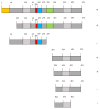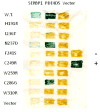The RNA-binding protein SERBP1 interacts selectively with the signaling protein RACK1
- PMID: 28267599
- PMCID: PMC5432400
- DOI: 10.1016/j.cellsig.2017.03.001
The RNA-binding protein SERBP1 interacts selectively with the signaling protein RACK1
Abstract
The RACK1 protein interacts with numerous proteins involved in signal transduction, the cytoskeleton, and mRNA splicing and translation. We used the 2-hybrid system to identify additional proteins interacting with RACK1 and isolated the RNA-binding protein SERBP1. SERPB1 shares amino acid sequence homology with HABP4 (also known as Ki-1/57), a component of the RNA spicing machinery that has been shown previously to interact with RACK1. Several different isoforms of SERBP1, generated by alternative mRNA splicing, interacted with RACK1 with indistinguishable interaction strength, as determined by a 2-hybrid beta-galactosidase assay. Analysis of deletion constructs of SERBP1 showed that the C-terminal third of the SERBP1 protein, which contains one of its two substrate sites for protein arginine N-methyltransferase 1 (PRMT1), is necessary and sufficient for it to interact with RACK1. Analysis of single amino acid substitutions in RACK1, identified in a reverse 2-hybrid screen, showed very substantial overlap with those implicated in the interaction of RACK1 with the cAMP-selective phosphodiesterase PDE4D5. These data are consistent with SERBP1 interacting selectively with RACK1, mediated by an extensive interaction surface on both proteins.
Keywords: 2-Hybrid; HABP4; PDE4; PDE4D5; RACK1; SERBP1.
Copyright © 2017 Elsevier Inc. All rights reserved.
Figures





Similar articles
-
The RACK1 signaling scaffold protein selectively interacts with the cAMP-specific phosphodiesterase PDE4D5 isoform.J Biol Chem. 1999 May 21;274(21):14909-17. doi: 10.1074/jbc.274.21.14909. J Biol Chem. 1999. PMID: 10329691
-
RACK1 Associates with RNA-Binding Proteins Vigilin and SERBP1 to Facilitate Dengue Virus Replication.J Virol. 2022 Apr 13;96(7):e0196221. doi: 10.1128/jvi.01962-21. Epub 2022 Mar 10. J Virol. 2022. PMID: 35266803 Free PMC article.
-
Scanning peptide array analyses identify overlapping binding sites for the signalling scaffold proteins, beta-arrestin and RACK1, in cAMP-specific phosphodiesterase PDE4D5.Biochem J. 2006 Aug 15;398(1):23-36. doi: 10.1042/BJ20060423. Biochem J. 2006. PMID: 16689683 Free PMC article.
-
The cyclic AMP phosphodiesterase 4D5 (PDE4D5)/receptor for activated C-kinase 1 (RACK1) signalling complex as a sensor of the extracellular nano-environment.Cell Signal. 2017 Jul;35:282-289. doi: 10.1016/j.cellsig.2017.01.013. Epub 2017 Jan 6. Cell Signal. 2017. PMID: 28069443 Review.
-
Structural analysis of ribosomal RACK1 and its role in translational control.Cell Signal. 2017 Jul;35:272-281. doi: 10.1016/j.cellsig.2017.01.026. Epub 2017 Feb 2. Cell Signal. 2017. PMID: 28161490 Review.
Cited by
-
Evaluating Imide-Based Mass Spectrometry-Cleavable Cross-Linkers for Structural Proteomics Studies.JACS Au. 2024 Jul 16;4(8):2936-2943. doi: 10.1021/jacsau.4c00282. eCollection 2024 Aug 26. JACS Au. 2024. PMID: 39211594 Free PMC article.
-
SERBP1-PCIF1 complex-controlled m6Am modification in glutamatergic neurons of the primary somatosensory cortex is required for neuropathic pain in mice.Nat Commun. 2025 Aug 5;16(1):7225. doi: 10.1038/s41467-025-62565-5. Nat Commun. 2025. PMID: 40764612 Free PMC article.
-
PEBP1 suppresses HIV transcription and induces latency by inactivating MAPK/NF-κB signaling.EMBO Rep. 2020 Nov 5;21(11):e49305. doi: 10.15252/embr.201949305. Epub 2020 Sep 14. EMBO Rep. 2020. PMID: 32924251 Free PMC article.
-
Complex interactomes and post-translational modifications of the regulatory proteins HABP4 and SERBP1 suggest pleiotropic cellular functions.World J Biol Chem. 2019 Nov 21;10(3):44-64. doi: 10.4331/wjbc.v10.i3.44. World J Biol Chem. 2019. PMID: 31768228 Free PMC article. Review.
-
Structural Characterization of the RNA-Binding Protein SERBP1 Reveals Intrinsic Disorder and Atypical RNA Binding Modes.Front Mol Biosci. 2021 Sep 24;8:744707. doi: 10.3389/fmolb.2021.744707. eCollection 2021. Front Mol Biosci. 2021. PMID: 34631798 Free PMC article.
References
-
- McCahill A, Warwicker J, Bolger GB, Houslay MD, Yarwood SJ. The RACK1 scaffold protein: a dynamic cog in cell response mechanisms. Mol Pharmacol. 2002;62:1261–73. - PubMed
-
- Mochly Rosen D, Khaner H, Lopez J, Smith BL. Intracellular receptors for activated protein kinase C. Identification of a binding site for the enzyme. J Biol Chem. 1991;266:14866–8. - PubMed
MeSH terms
Substances
Grants and funding
LinkOut - more resources
Full Text Sources
Other Literature Sources

